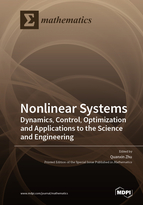Nonlinear Systems: Dynamics, Control, Optimization and Applications to the Science and Engineering
A special issue of Mathematics (ISSN 2227-7390). This special issue belongs to the section "Engineering Mathematics".
Deadline for manuscript submissions: closed (31 May 2022) | Viewed by 25323
Special Issue Editor
Interests: Markov processes; stochastic differential equations; stochastic partial differential equations; stochastic stability; stochastic neural networks
Special Issues, Collections and Topics in MDPI journals
Special Issue Information
Dear Colleagues,
Open Mathematics is a challenging notion for theoretical modeling, technical analysis, and numerical simulation in physics and mathematics, as well as in many other fields, as highly correlated nonlinear phenomena, evolving over a large range of time scales and length scales, control the underlying systems and processes in their spatiotemporal evolution. Indeed, available data, be it physical, biological, or financial, technological complex systems and stochastic systems, such as mechanical or electronic devices, can be managed from the same conceptual approach, both analytically and through computer simulation, using effective nonlinear dynamics methods.
The aim of this Special Issue is to highlight papers that show dynamics, control, optimization and applications of nonlinear systems. This has recently become an increasingly popular subject, with impressive growth concerning applications in engineering, economics, biology, and medicine, and can be considered a veritable contribution to the literature. Original papers relating to the objective presented above are especially welcome subjects.
Potential topics include but are not limited to the following:
- Stability analysis of discrete and continuous dynamical systems;
- Nonlinear dynamics in biological complex systems;
- Stability and stabilization of stochastic systems;
- Mathematical models in statistics and probability;
- Synchronization of oscillators and chaotic systems;
- Optimization methods of complex systems;
- Reliability modeling and system optimization;
- Computation and control over networked systems.
Prof. Dr. Quanxin Zhu
Guest Editor
Manuscript Submission Information
Manuscripts should be submitted online at www.mdpi.com by registering and logging in to this website. Once you are registered, click here to go to the submission form. Manuscripts can be submitted until the deadline. All submissions that pass pre-check are peer-reviewed. Accepted papers will be published continuously in the journal (as soon as accepted) and will be listed together on the special issue website. Research articles, review articles as well as short communications are invited. For planned papers, a title and short abstract (about 100 words) can be sent to the Editorial Office for announcement on this website.
Submitted manuscripts should not have been published previously, nor be under consideration for publication elsewhere (except conference proceedings papers). All manuscripts are thoroughly refereed through a single-blind peer-review process. A guide for authors and other relevant information for submission of manuscripts is available on the Instructions for Authors page. Mathematics is an international peer-reviewed open access semimonthly journal published by MDPI.
Please visit the Instructions for Authors page before submitting a manuscript. The Article Processing Charge (APC) for publication in this open access journal is 2600 CHF (Swiss Francs). Submitted papers should be well formatted and use good English. Authors may use MDPI's English editing service prior to publication or during author revisions.






